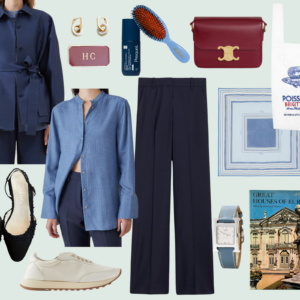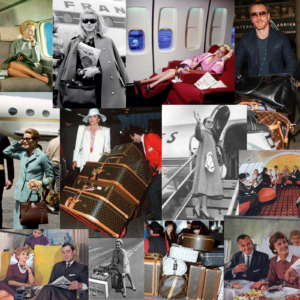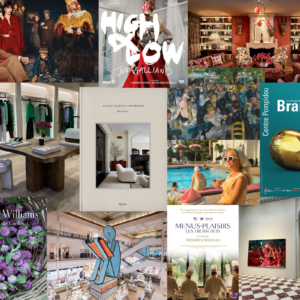Upcoming Hubert de Givenchy Collectionneur Auction at Christie’s
by habituallychic
02 . 07 . 22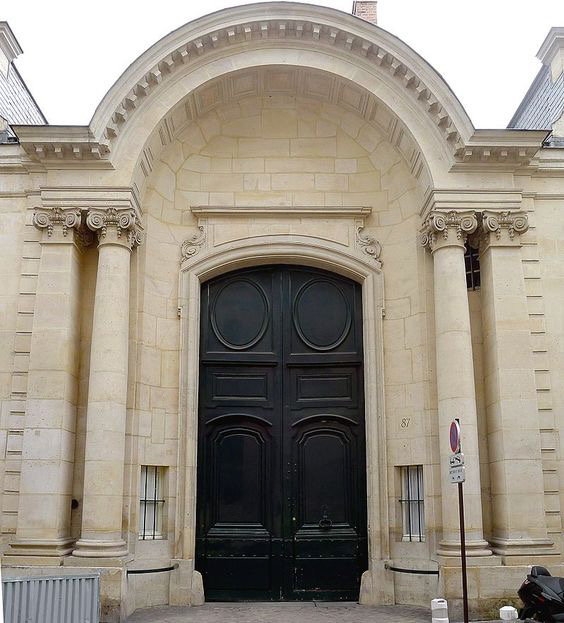
Editor’s Note: If you follow me on Instagram, you probably already know that I was dealing with a pretty bad case of food poisoning last week. It began Wednesday evening when I was working on this post. I’m happy to say that I’m finally feeling better and glad to be back at the blog.
Last Wednesday, Christie’s in Paris announced that they would be offering the “sale of the exceptional fine and decorative arts collection of the late legendary fashion designer Hubert de Givenchy, featuring more than 1,200 lots of French and European Furniture and works of art, including sculpture and paintings from Old Masters to Modern and Contemporary works.”
“Each object was chosen with Hubert de Givenchy’s meticulous eye and reflects his exquisite taste. Drawn from two of de Givenchy’s most iconic and elegant homes—the Hôtel d’Orrouer in Paris and the Château du Jonchet in the Loire Valley—the collection includes many exceptional objects unseen on the market for decades as well as more recent works acquired towards the end of his collecting journey. Christie’s will offer this extraordinary collection at auction in Paris from 14 to 17 June (live sales) and from 8 to 23 June 2022 in a dedicated online sale.”
“The timing of the announcement of the sale coincides with the 70th anniversary of the first haute couture collection Hubert de Givenchy presented in Paris on 2nd of February 1952, which was a resounding international success.”
I thought this would be a good time to look into the history and interiors of the m. de Givenchy’s hôtel particulier, Hôtel d’Orrouer in Paris which I have not posted before.
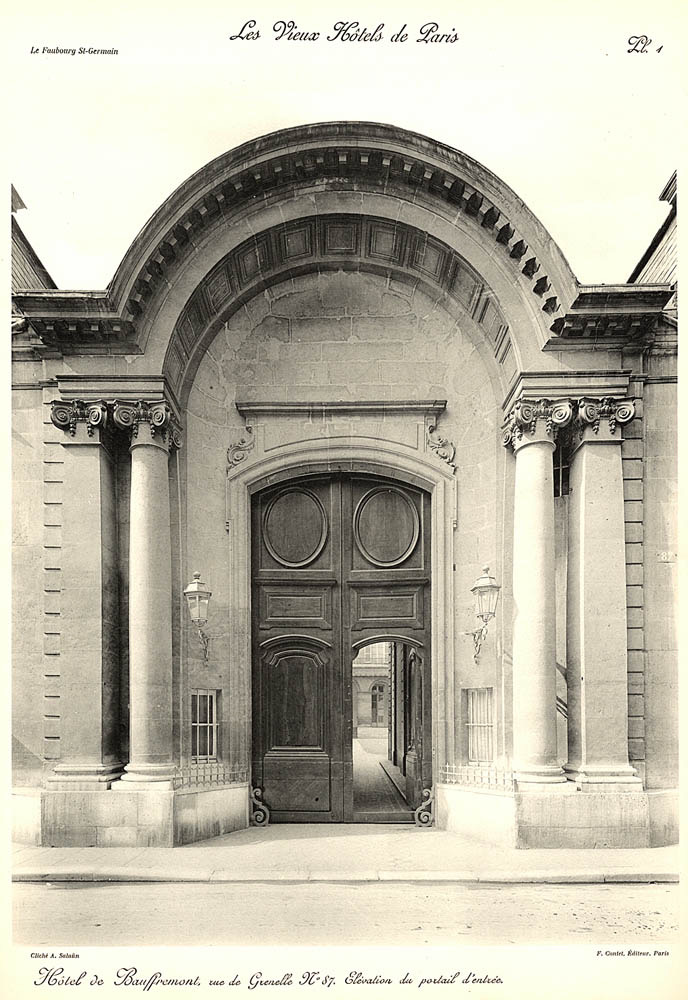
The Hôtel d’Orrouer, which is also sometimes referred to as the Hôtel de Bauffremont, was built by the architects Charles and Pierre Boscry in 1732 for the campmaster of the Anjou regiment, Paul de Grivel de Grossouvre, count of Orrouer at 87 rue de Grenelle. It developed the repertoire of the regency and the first years of the reign of Louis XV with its ornaments, boiseries, and fireplaces designed by Nicolas Pineau (1684-1754).
After the disappearance of the Count of Orrouer in 1752, the hotel would be occupied successively by the Duke of Luynes, then rented to Marie de Boisgelin, canoness of Remiremont, and finally acquired by the Duke of Montmorency for 300,000 francs. It was inherited by his daughter Anne-Elisabeth, the wife of the Prince de Bauffremont, and her family lived there for over a century. The hôtel particulier is also referred to as the Hôtel de Bauffremont d’Orrouer.
In 1850 it became the residence of Prince de Metternich, Austrian Ambassador to Paris. But in 1861 he took possession of the Hotel de Rothelin-Charolais at 101 rue de Grenelle, a few numbers higher, which had just been abandoned by the Minister of the Interior for the Hotel de Beauvau. It was then that Orrouer entered the property of the Prince of Bauffremont who kept it until 1935. Not sure who owned it after but it was bought by Hubert de Givenchy in 1986.
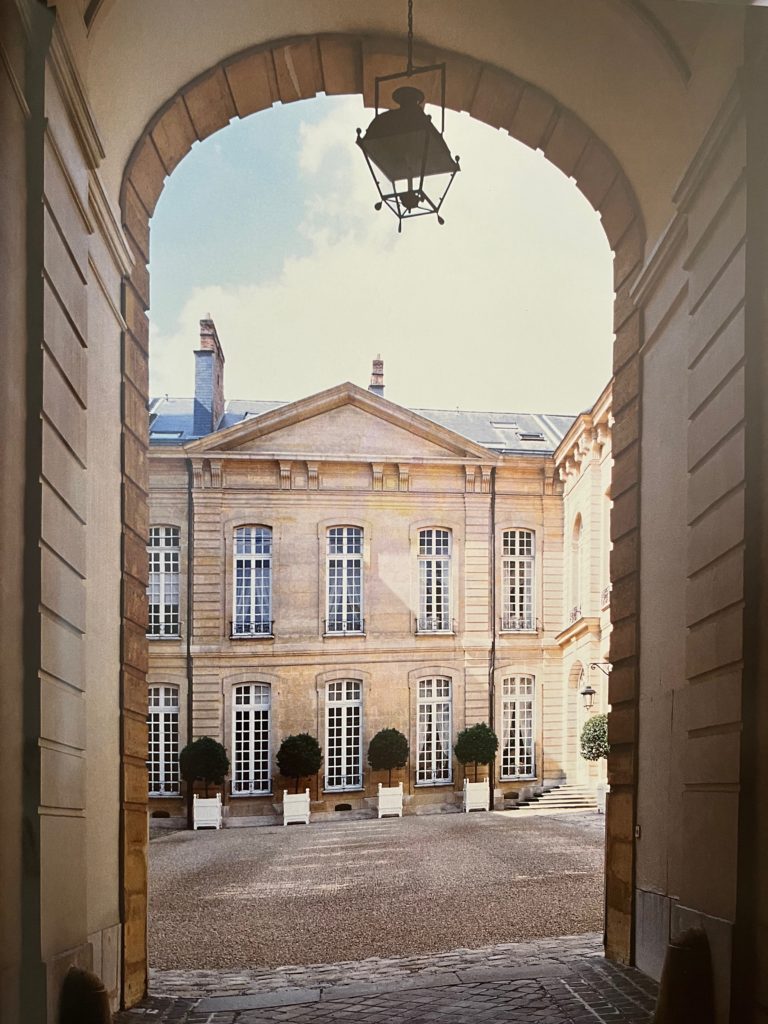
Hubert de Givenchy had lived at the Hôtel de Cavoye on rue des Saint-Pères before moving to the Hôtel d’Orrouer in 1986. He told Architectural Digest, “I was never especially attached to the Hôtel de Cavoye. On the other hand, when I opened the door of the Hôtel d’Orrouer I immediately knew I had to live here and nowhere else. My original plan was to make the second floor a sort of showcase for the furniture and objects, while the first floor with the garden would be kept separate for summer living.”
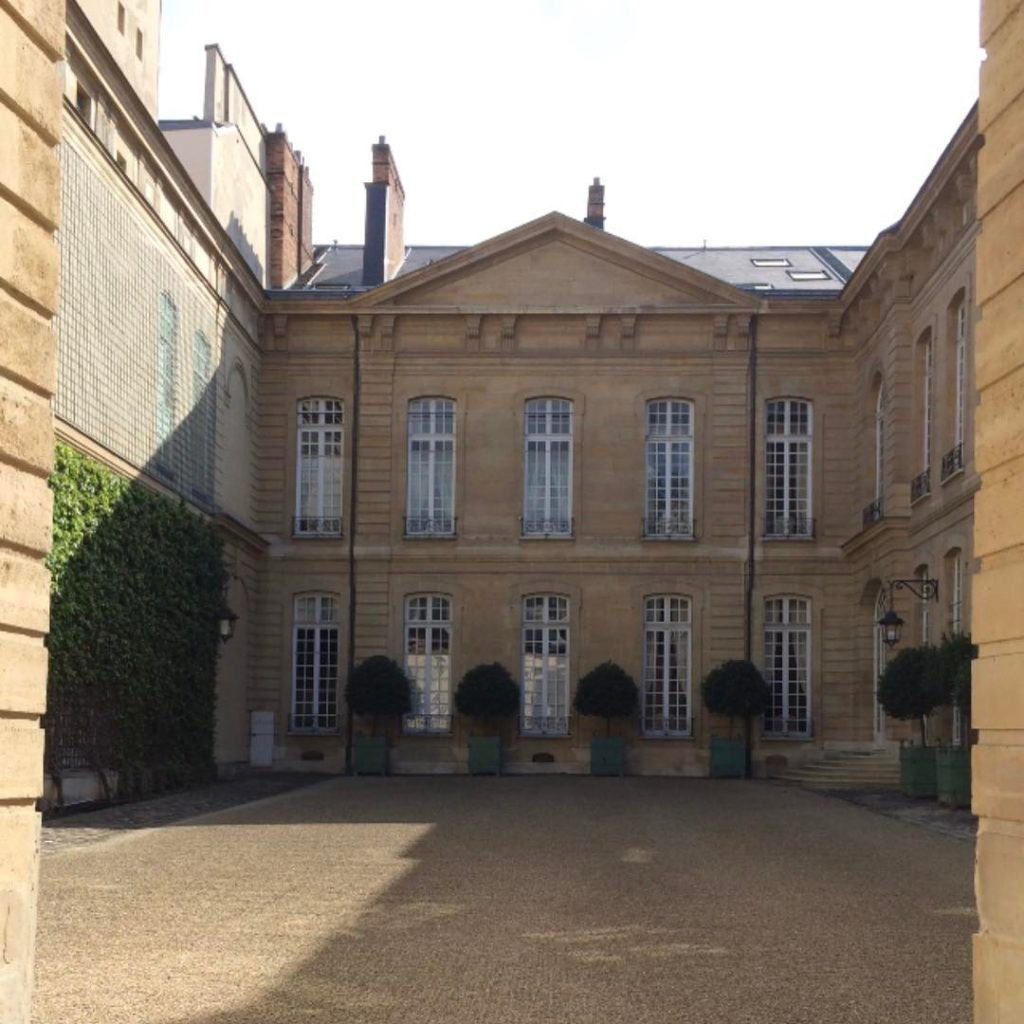
According to Apollo magazine, “When one of the great wooden doors of its triumphal arch of a porte-cochère opens, it reveals a courtyard of gravel and box, plus two classical golden-stone façades of such pared-down simplicity that they verge on the austere.”
It should be noted that at some point, the two parts of the hôtel particulier were separated and Hubert de Givenchy owned the main section that opens up to the garden.
The right section was owned by Susan and John Gutfreund. I’m not sure when it was purchased but it featured in the January/February 2011 issue of Veranda to coincide with the auction of the contents by Christie’s in Paris. It was designed by Henri Samuel and architect Alain Reynaud and was filled with 18th-century antiques. The Gutfreund section was purchased by Delphine and Reed Krakoff and I posted a look at the decor of both iterations in my post One Paris Apartment Two Ways and an Auction.
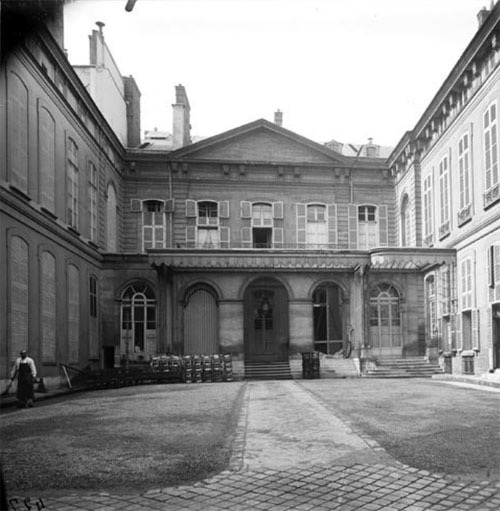
There is no date available for this photo but it was take by Jean Eugène Auguste Atget who died at the age of 70 in 1927 so it was obviously taken before that date. It shows that at some point later, the facade was changed but the entrance remained in the back right corner. It’s interesting that the shutters were removed since they are traditional French design element that are also used to protect homes when the owners are away.
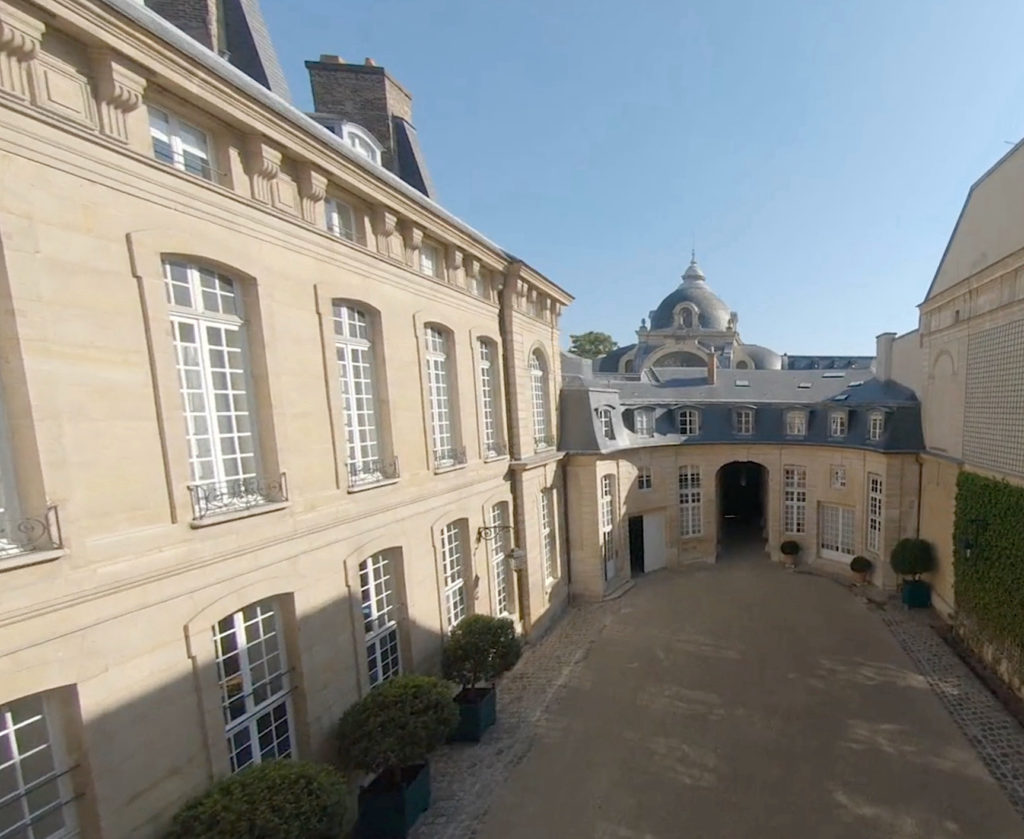
I took a screen shot of this view of the porte-cochere from the Christie’s drone video of the properties.

This photo from Jean Eugène Auguste Atget shows that the porte-cochere looks virtually unchanged.
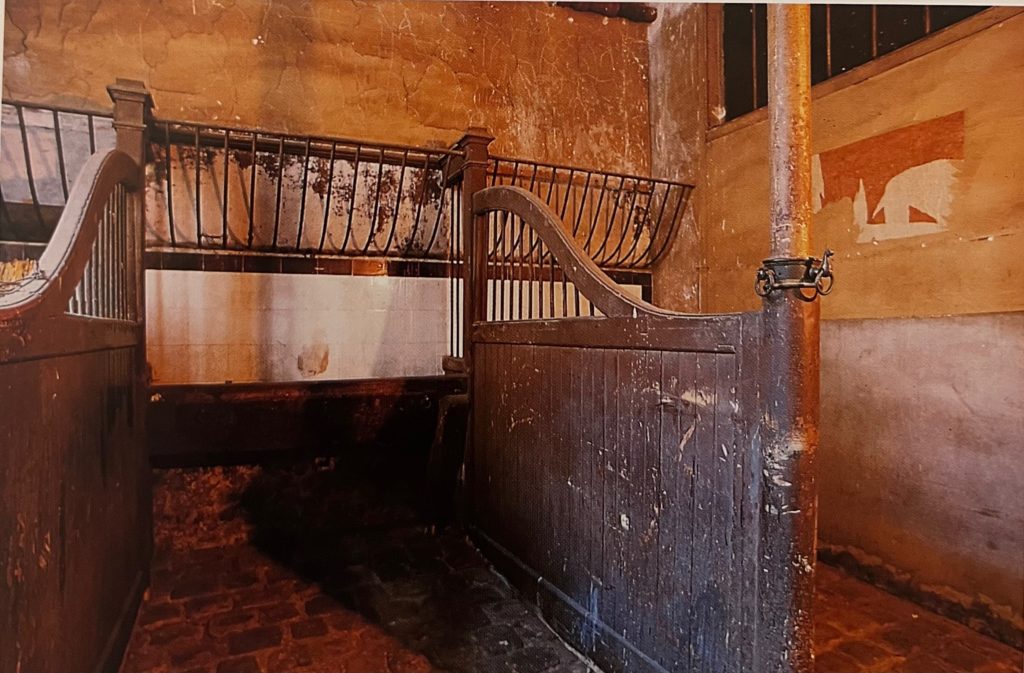
According to the book The Finest Houses of Paris, the porte-cochere housed servants rooms and a stable for up to twenty-five horses. Above is a photo of the original stables from when it was owned by Hubert de Givenchy. I wonder if the current owners have kept them.
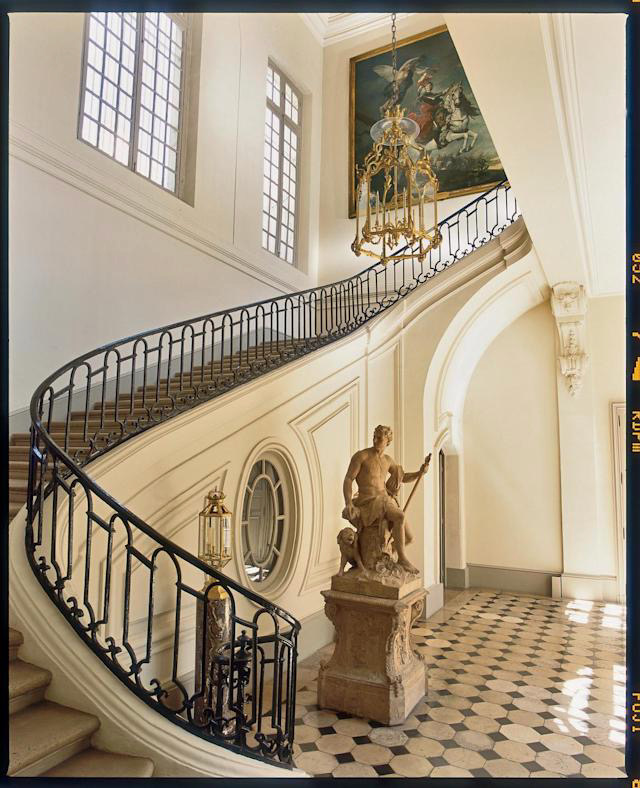
The grand staircase and entrance hall that is shared by both sides of the hôtel particulier. The statue of Apollon Chasseur by Nicolas Coustou also stood in the entrance of the Hôtel de Cavoye that M. de Givenchy owned prior to Hôtel d’Orrouer. The Louis XV lantern was made for the marquise de Pompadour for the Château de Saint-Hubert.

This old photo shows that the grand staircase remains unchanged.
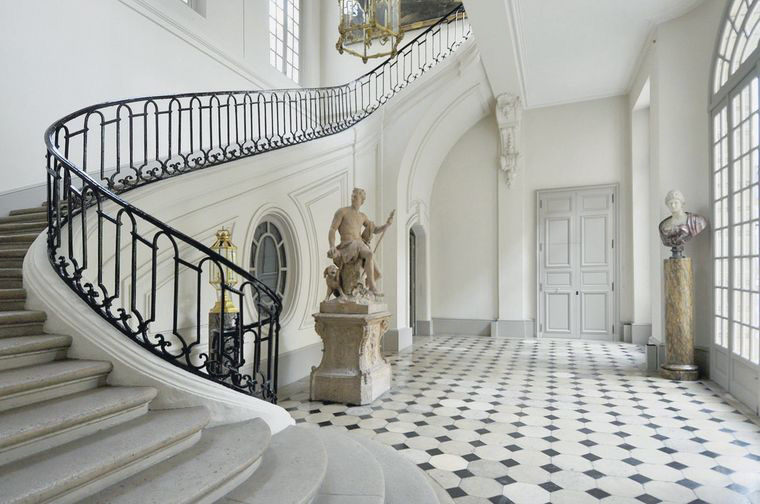
This wider view shows the door to the section owned by the Gutfreunds and now the Krakoffs. The Krakoff apartment also has an internal staircase but I haven’t seen one in Givenchy’s apartment although I assume there must be one even if it was just a servant’s staircase.
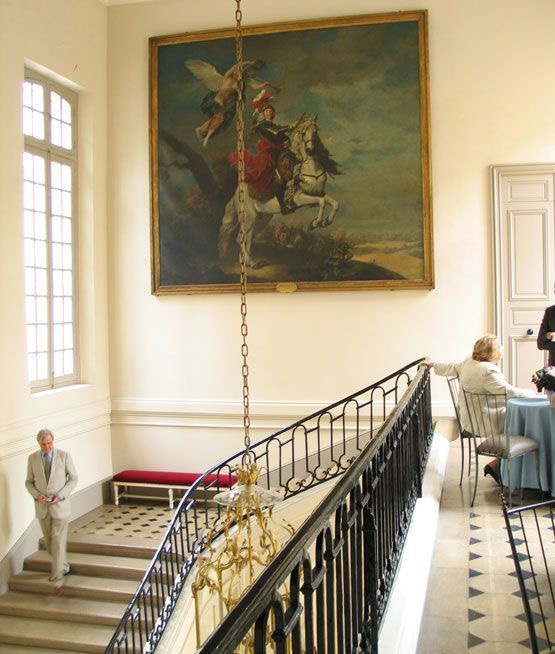
This photo from New York Social Diary shows the second floor door to the Gutfreund residence at the time.

While there are images of the entrances on the first and second floors of the Gutfreund and Krakoff interiors, there is no photo of how one entered M. de Givenchy’s home. This view is of the Grand Salon from the Salon Vert on the second floor.
“Once inside the hôtel, it is clear that the same elegant aesthetic is at work. There is opulence and luxury in terms of materials – ormolu-mounted or gilded furniture, mirrors, candelabra, hardstone vessels, mirror-black vases and bronzes, plus rich embroideries and carpets – and a profusion of objects, but there is a rigour and symmetry in their arrangement that ensures an effect that is masculine and surprisingly unfussy. Nothing is extraneous. As his great mentor Cristóbal Balenciaga once said: the secret of elegance is elimination.”
Via Apollo Magazine
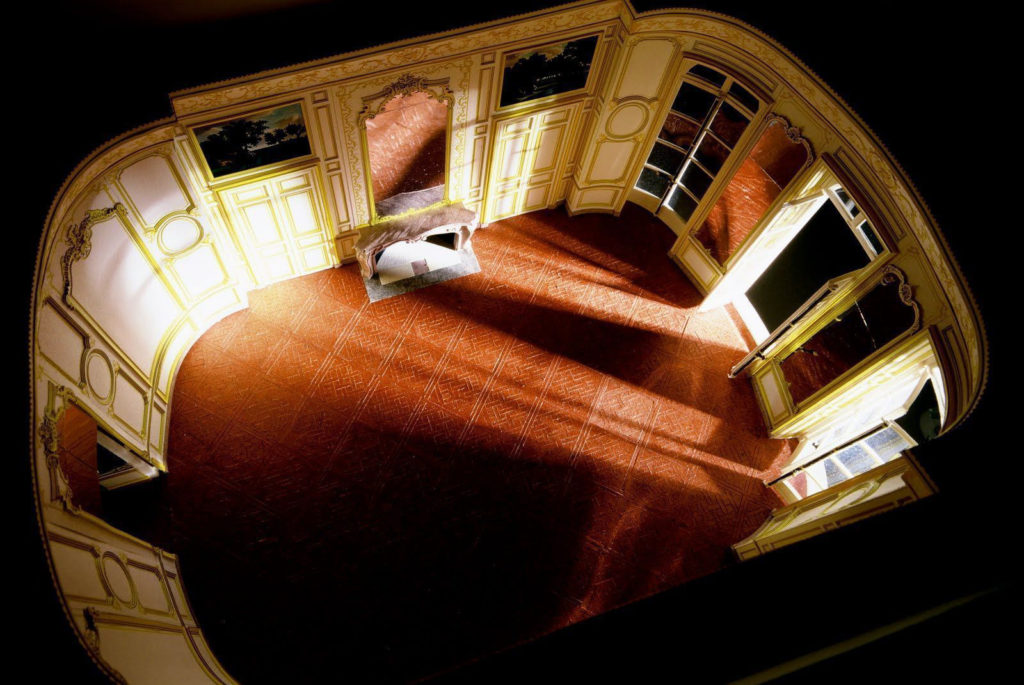
A view that shows an overview of the oval Grand Salon.
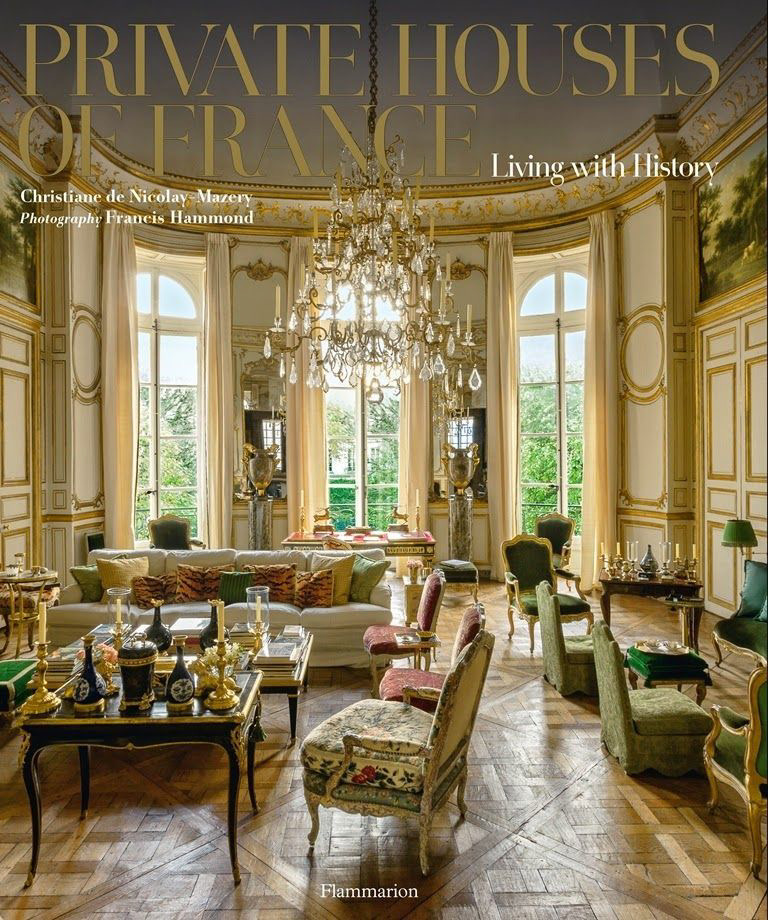
Hubert de Givenchy’s home was also featured in the book, Private Houses of France. The Grand Salon overlooks the large garden.
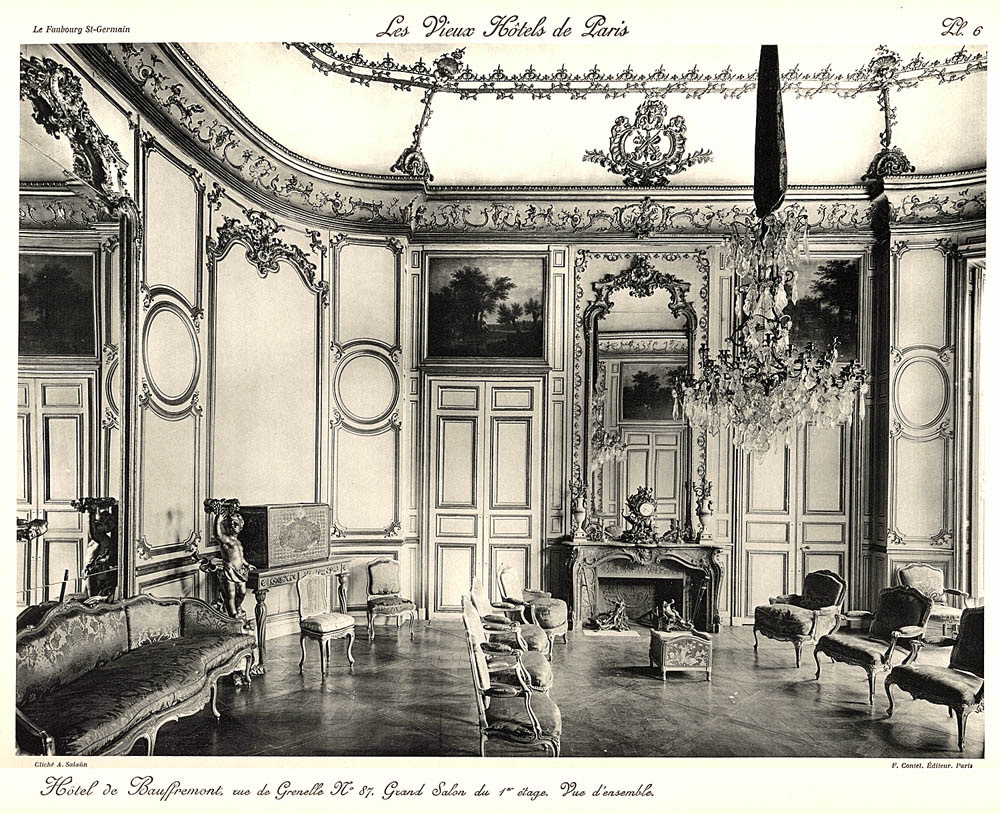
An old view of the Grand Salon du premier étage. The first floor in Europe is the second floor to Americans.
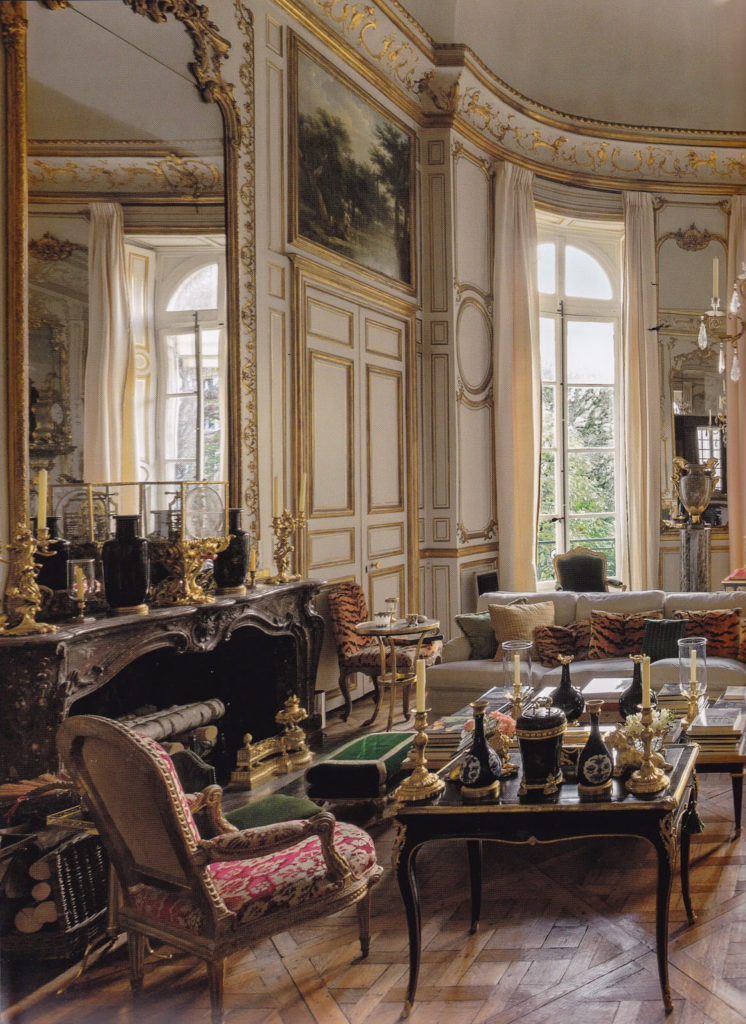
Givenchy has always seen the furnishing and decoration of his various apartments as an extension of his work as a designer. ‘What I try to achieve is principally a harmony between architecture, decoration and colour,’ he explains, as we sit at his desk overlooking a manicured garden. He offers me a choice of tea, coffee, water, Coca-Cola or Champagne, duly delivered by a white-coated butler. ‘This house already has a marvellous decoration of its own with the gilded boiseries of Nicolas Pineau, so I did not need to “decorate” very much. But I do try to find associations between objects in a way that looks natural. I am not interested in creating something that people say is different or amusing.’
Via Apollo Magazine
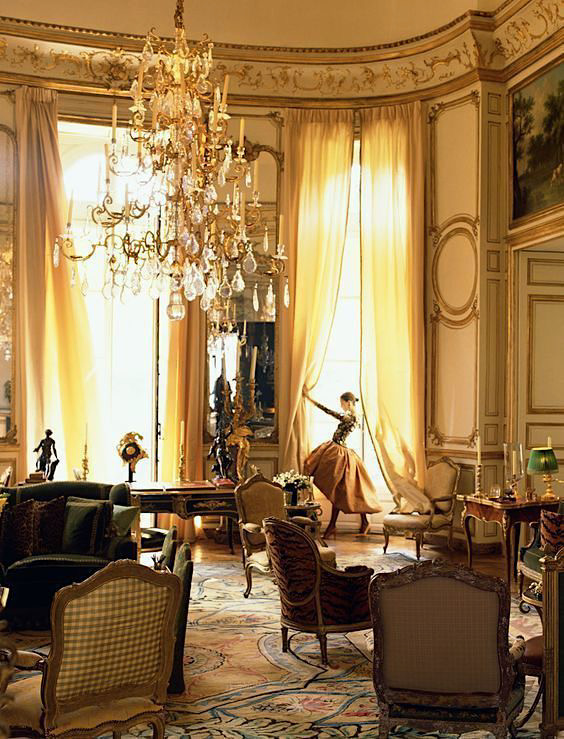
A photo from a photo shoot in the Grand Salon which also graces the cover of The Givenchy Style book.

A bouquet of eremurus or foxtail lilies in a giant thimble vessel.
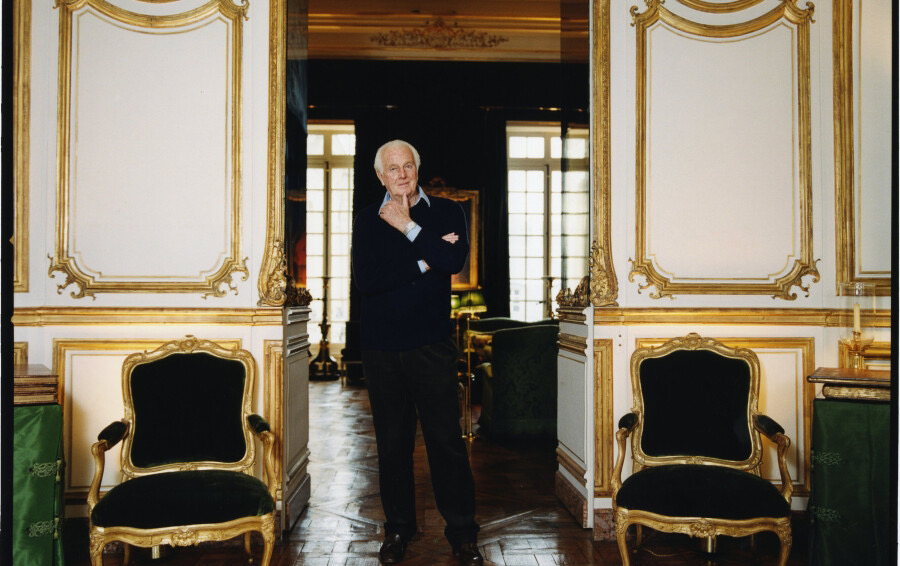
“Little by little, I pursued my dream of acquiring furniture from the 17th and 18th centuries, and contemporary art.” – Hubert de Givenchy

On Misia Sert, ‘Her apartment was like an Ali Baba’s cave,’ he recalls, ‘and it was incredible. The taste of her close friend Coco Chanel was in fact the taste of Misia – rock crystal, coromandel, gilt bronze and Boulle…and there was a particular Boulle armoire…’ After Misia’s death in 1950, Sert’s former secretary, the journalist Boulos (Pierre Ristelhueber), contacted Givenchy to ask him if he knew anyone who might buy the armoire as no one seemed to be in the least bit interested in Boulle. ‘On the front of the armoire was a chariot of Apollo and the bronze was of extraordinary quality – I would dream in front of that bronze,’ sighs Givenchy.
He asked around, offering the piece to Helena Rubenstein, the Princesse Gourielli. ‘One day, Boulos said: “Every time you visit you touch the armoire and caress the horses. Why don’t you buy it?” I said the price is impossible and I have nothing like it! In fact, when he told me the price I was so surprised that I said yes.’
Via Apollo Magazine

His dear friend Audrey Hepburn photographed in the Salon Vert in 1991.

“What is important is to create, and creation is the most important thing in life for me.” – Hubert de Givenchy
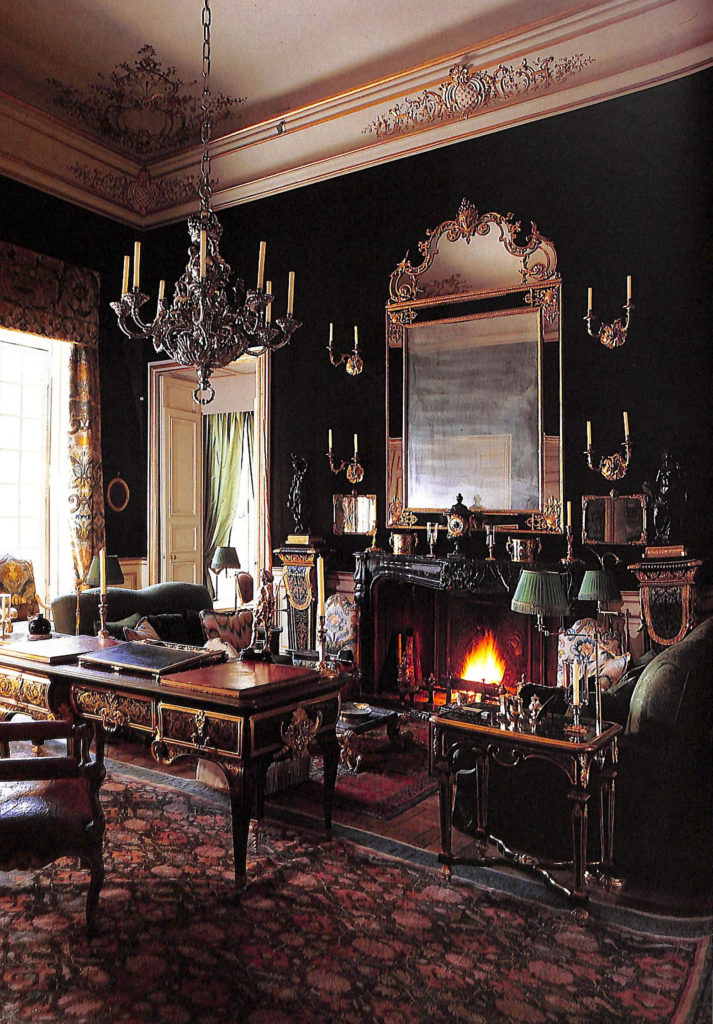
After he sold his company in 1988, Givenchy decided it would be a good idea to sell the piano nobile of the Hôtel d’Orrouer and move downstairs into the pied-à-terre (he had three labradors at the time and was planning to spend more time in the country. At this point in the story he has the good grace to laugh and say: ‘What a pied-à-terre!’ for the ground-floor apartment is a mirror of the one above, but with slightly lower ceilings. The principal contents of the piano nobile were duly sold by Christie’s in Monaco in 1993, where they set a record for a single-owner collection of decorative arts, and the heavenly project of creation began again – twice, after he decided not to sell the piano nobile after all.
Via Apollo Magazine
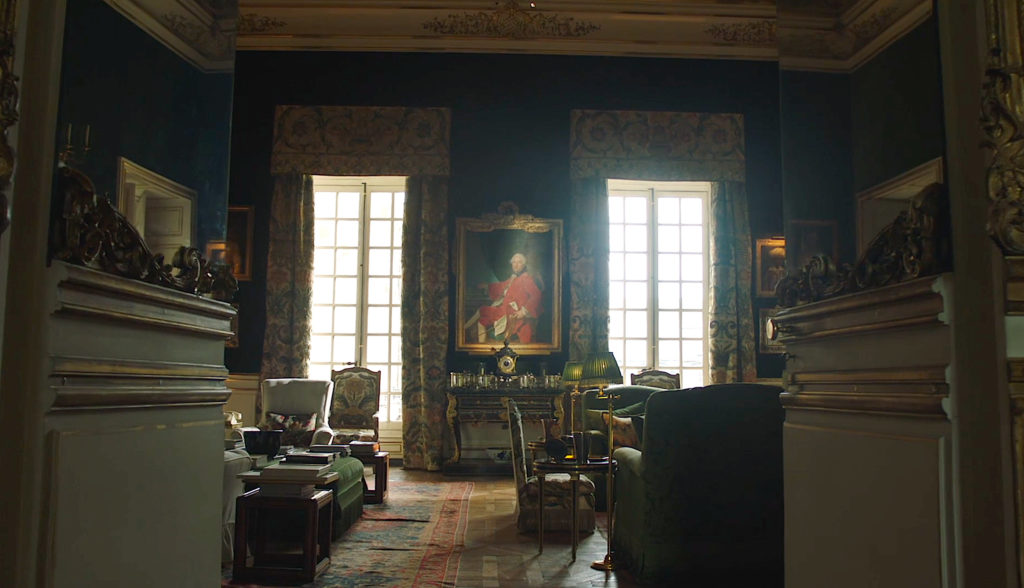
A view into the Salon Vert that faces the front courtyard from the Christie’s drone video. Between the two windows is a portrait of the financier Étienne-Michel Bouret above a commode by André-Charles Boulle.

According to Private Houses of France, the Salon Vert “has sumptuous 17th-century silk curtains embroidered with a floral design in colored silks and gold and silver thread, which came from the Hôtel de Masseran, former residence of Baron and Baroness Élie de Rothschild.”
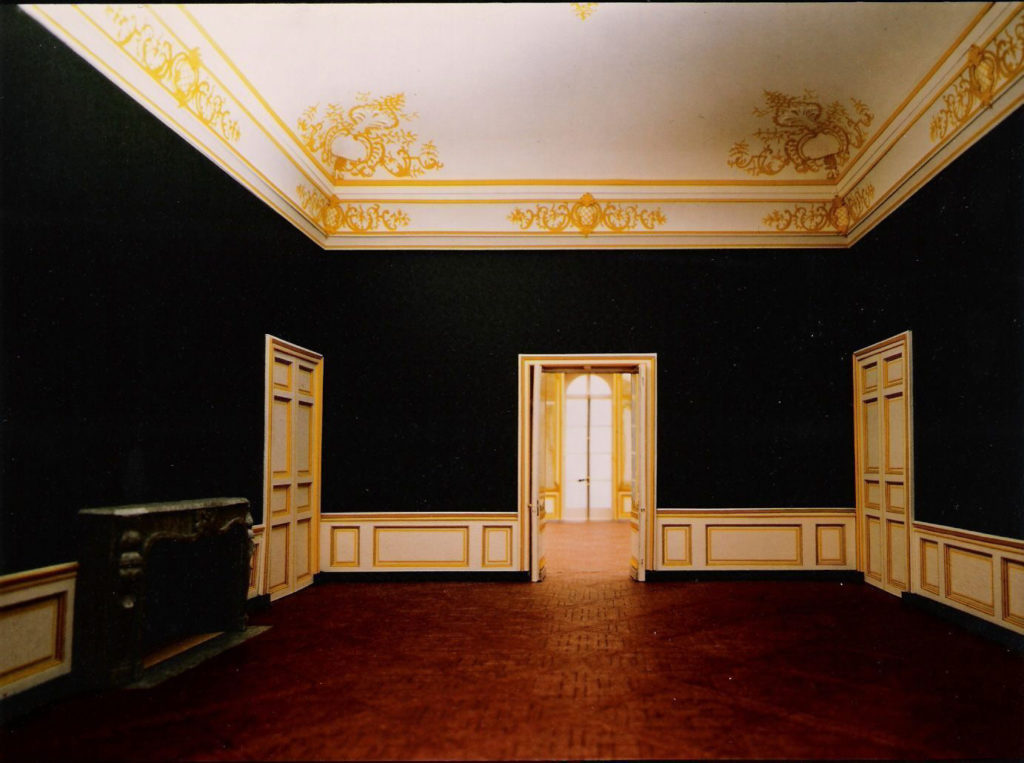
The Givenchy family kept the Château du Jonchet in the Loire Valley but sold the Hôtel d’Orrouer. It’s harder to find out real estate information in France than the US but it’s possibly owned by a former French or Belgian private banker.
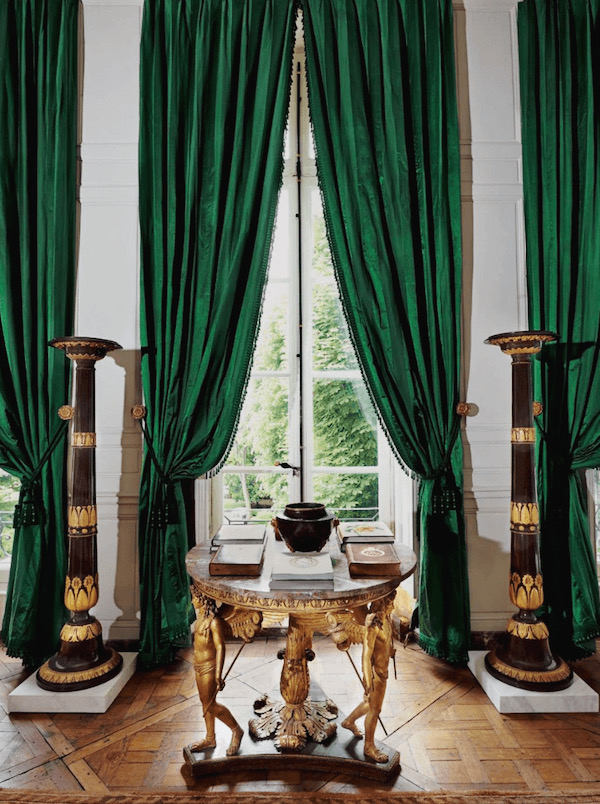
It was during a conversation with Christie’s Charles Cator and François de Ricqles that Givenchy revealed that he had long cherished the idea of creating his own modest version of La Galerie de Girardon. François Girardon, arguably the most influential sculptor in France under Louis XIV, was also an extraordinary collector of sculpture, amassing over 800 pieces that ranged from classical antiquities and copies after the antique to the contemporary. Around 1708, he commissioned René Charpentier to draw its highlights, and Gilles-Marie Oppenordt to design for them a grand and imaginary architectural setting. The subsequent engravings constitute an important record of both Girardon’s oeuvre and his collection.
Via Apollo Magazine
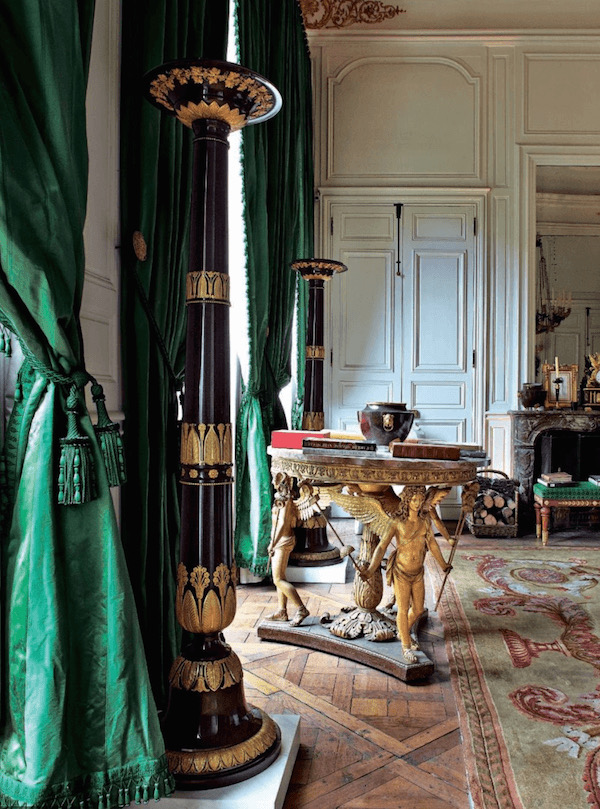
Cator was so enthusiastic about the idea that he suggested they stage it at Christie’s Paris as an exhibition to coincide with the Biennale des Antiquaires. The show, which ran from 11 to 26 September [in 2012], presented some 10 pieces, or pairs, from the Givenchy collection, set against a backdrop of the engraved Girardon plates. Most are bronzes, although two 17th- or 18th-century Italian polychrome marble busts of Claudius and Alexander the Great also took a bow, as did a pair of Louis XV marble vases of around 1700–65, which have astounding and apparently unique ormolu mounts of masks and snakes.
Givenchy insists that he knows ‘absolutely nothing’ about bronze. ‘It is all instinct,’ he says. He buys when a work of art delivers a coup de foudre and he knows he must live with it. Yet his is an incredibly sure eye, as these sculptures bear ample witness.
Via Apollo Magazine
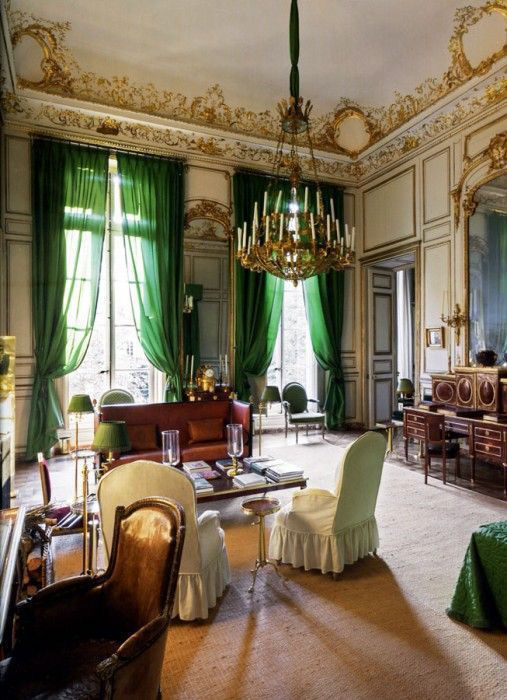
From Private Houses of France, “The guest room, as big as a salon, boasts an extremely rare double cornice by Nicolas Pineau, who worked with Pierre Boscry on the decorations of the Hôtel d’Orrouer.”
From what I can tell, this room sits to the left of the Grand Salon.
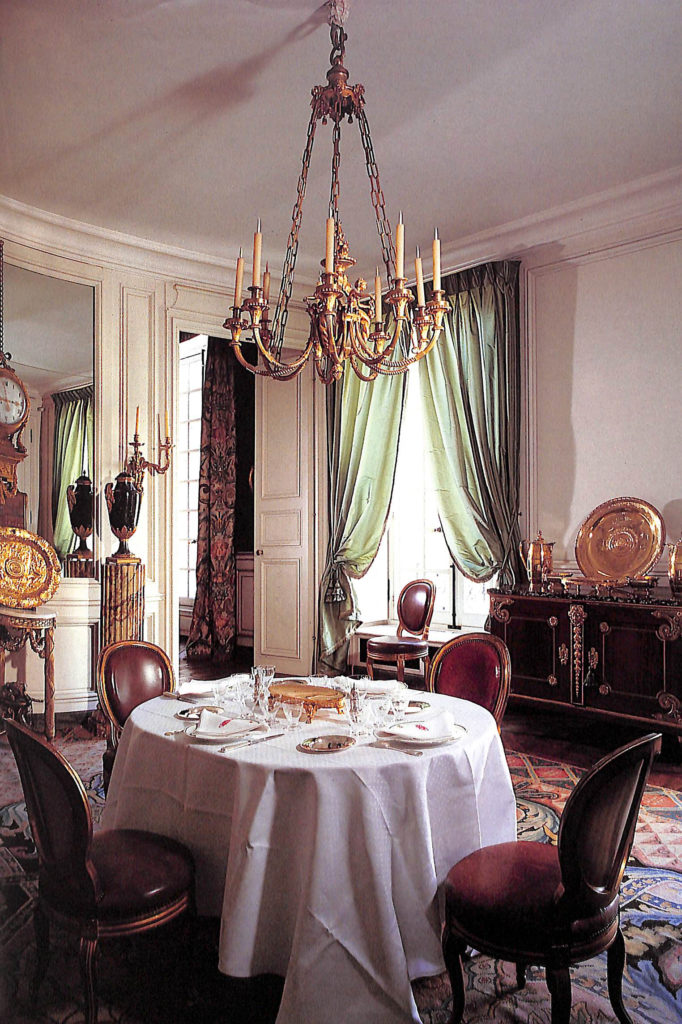
The dining rooms sits to the right of the Salon Vert facing the courtyard. It has lower ceilings than the larger salon rooms. My guesses as to why are that it was a private family room that would not be seen by guests or it was lower to allow for room upstairs in what was the servants area or an internal staircase.
This image is from the catalog Christie’s: The Collection of M. Hubert De Givenchy: Monaco Saturday 4 December 1993. Two of the giltwood chairs are Louis XVI, Signed G. Jacob, and twelve are from a later date. They sold at Christie’s for $163,000 in 1993.
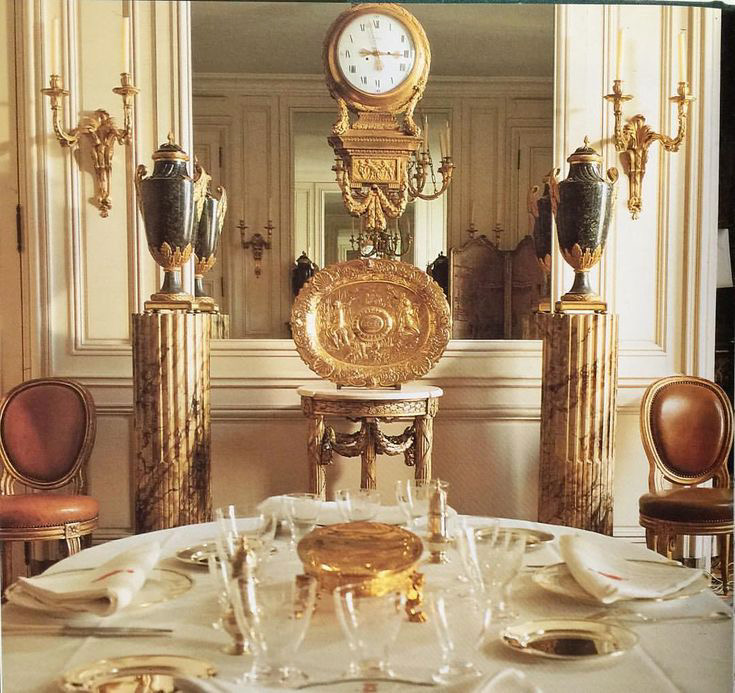
This image was also included in Christie’s: The Collection of M. Hubert De Givenchy: Monaco Saturday 4 December 1993. The pair of Louis XVI serpentine marble and gilt-bronze urns on the columns sold for $170,000 in 1993.
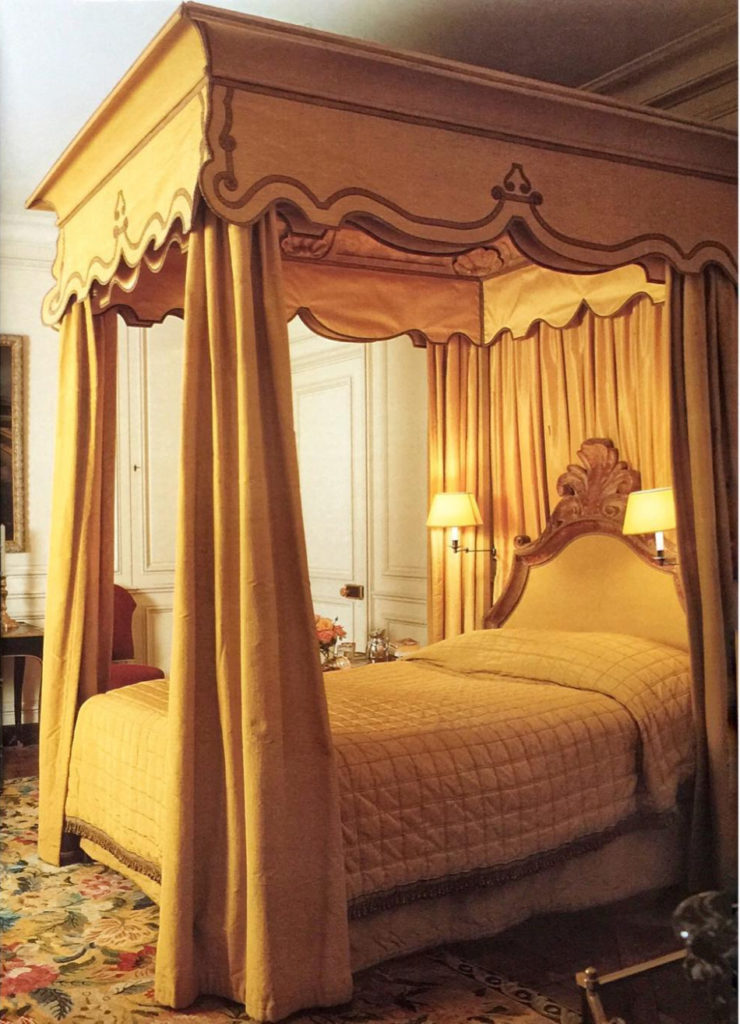
This bedroom also shares the same low ceiling as the dining room so it’s safe to assume that they sit on the same side of the house. This image was another included in Christie’s: The Collection of M. Hubert De Givenchy: Monaco Saturday 4 December 1993. It’s described as a Queen Anne four-post bed in yellow silk and damask and sold for $30,000 in 1993.
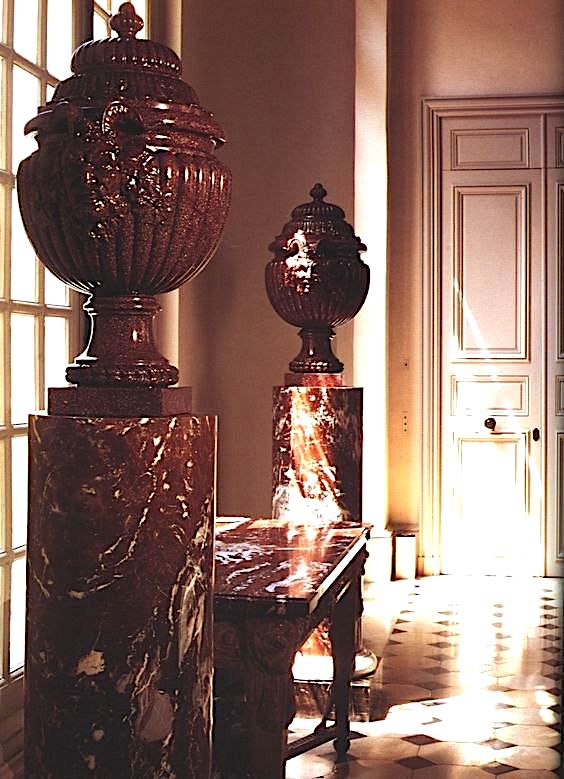
This image from The Givenchy Style includes “Louis XV porphyry vases, gadrooned and flanked by Bacchus masks and grape clusters.” These were also sold at the Christie’s sale in 1993 and sold for $500,000.
“My sudden separation from all those things gave me an odd feeling. Afterward, in the car, I wondered how I would respond to the emptiness at home. I opened the sale catalog and there was twenty years of my life. I reviewed it all, and I realized that the moment had come to embark on something completely new.” – Hubert de Givenchy
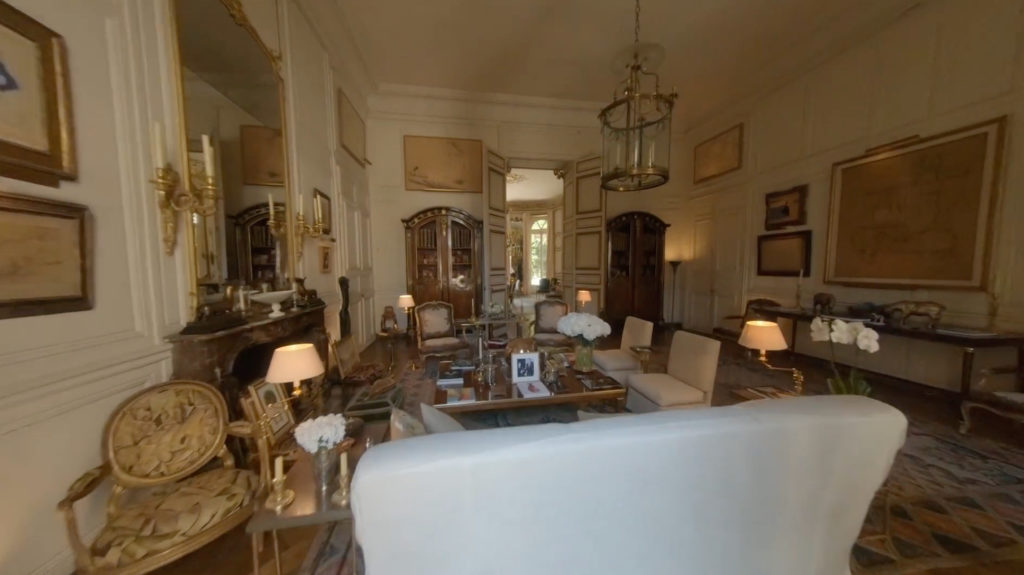
The Christie’s drone video sweeps through this more casually decorated antechamber on the ground floor on the courtyard side of the house.
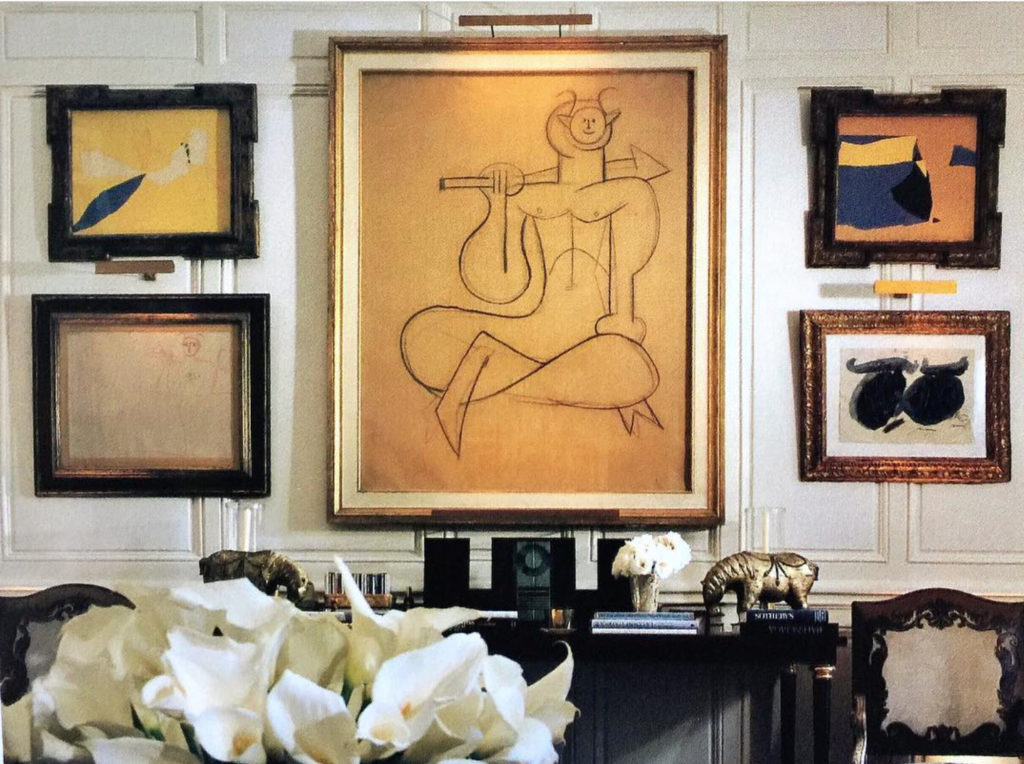
This Picasso drawing was first seen in the entrance hall of M. de Givenchy’s rue Fabert apartment. According to Architectural Digest, “To the right of Picasso’s ‘Le Grand Pan’ are a Nicolas de Staël collage (top) and a Tàpies oil; to the left are another de Staël collage and a second Picasso work from the ‘Antibes’ series. A modern porphyry table in the antechamber is flanked by a pair of Louis XIV arm chairs in suede and leather.”
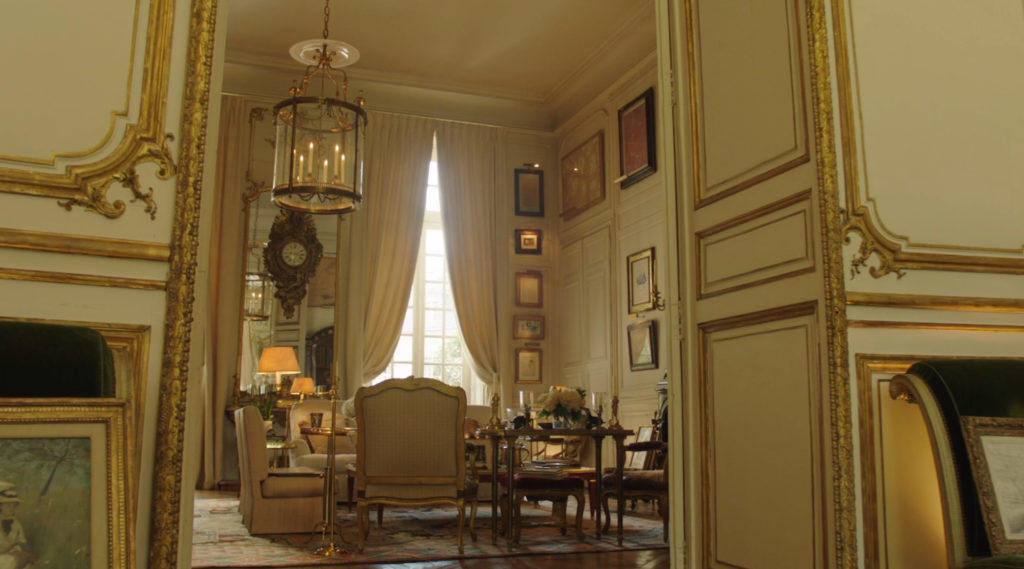
The view from the ground floor salon into the antechamber.
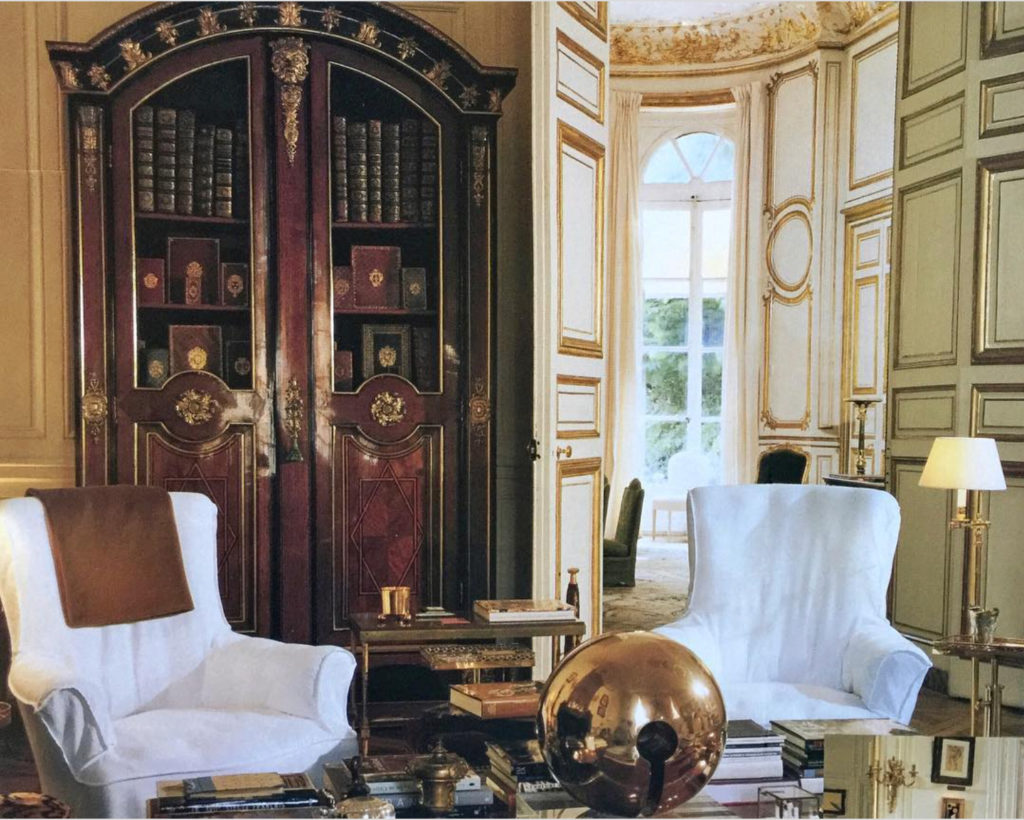
In the antechamber are a sphere by Arnaldo Pomodoro and a violet wood Louis XIV armoire.

The ground floor salon opens out onto the garden.
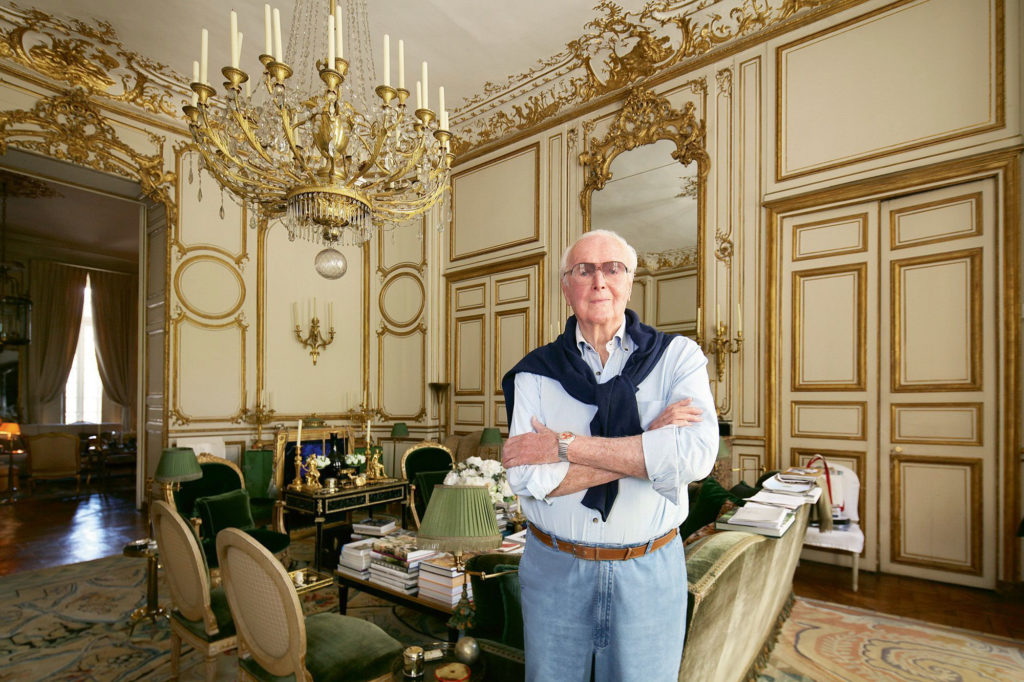
M. de Givenchy in the ground floor salon.
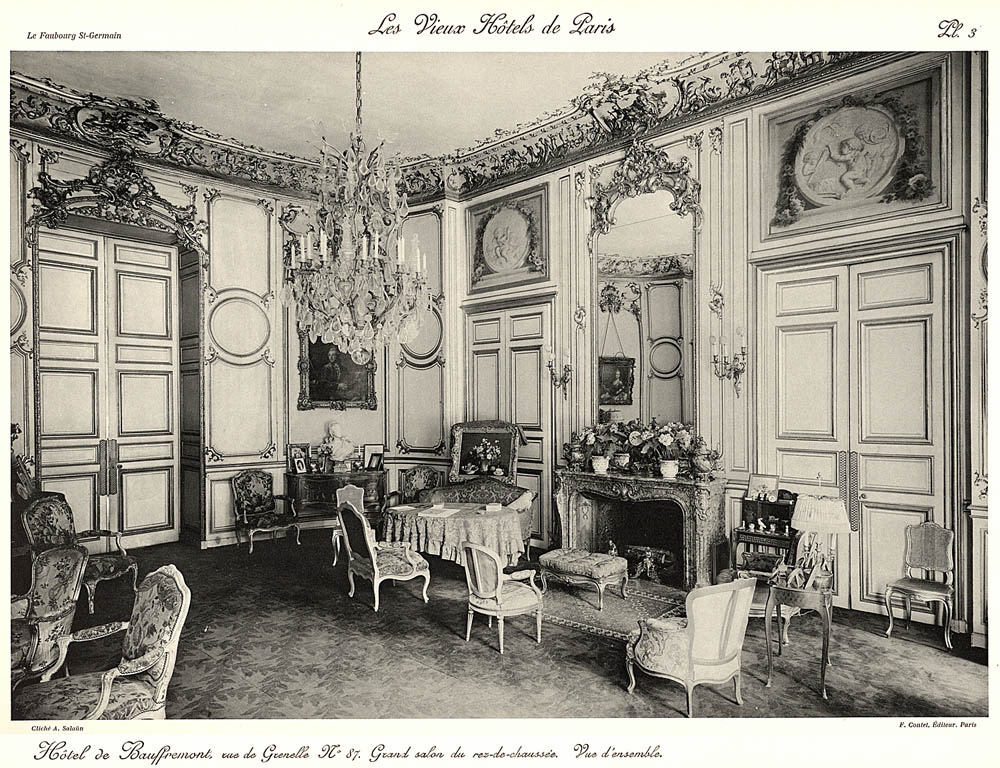
An old photograph of the ground floor grand salon.

M. de Givenchy had planned to live upstairs for part of the year and downstairs in the summer but said that plan only worked for seven years because his then dog became ill and could not climb the stairs anymore. That’s when he decided to “abandon the second floor and sell everything that didn’t go with the less pompous, more intimate approach I could already see on the horizon.”
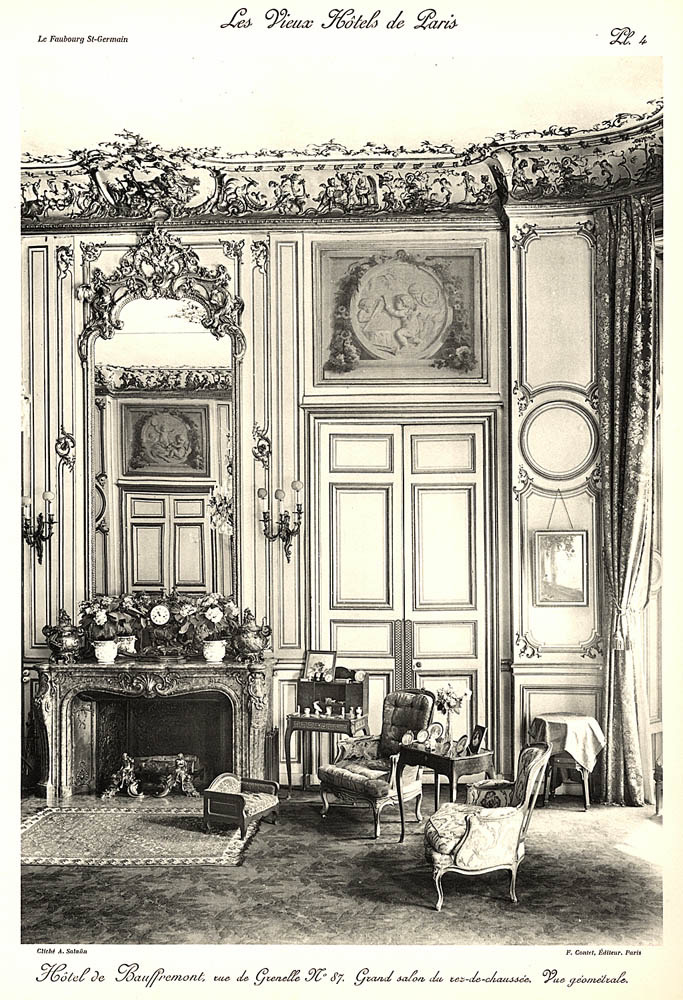
Another old photo of the ground floor grand salon.

Asked whether he regrets selling any works of art. ‘C’est la vie. Life has different stages. You must realise that in life what you want more and more is simplicity – a simple room, a perfect bed, one nice table, a few objects that you really like, and a good book.’ Perhaps the secret of life, like elegance, is elimination.
– Hubert de Givenchy
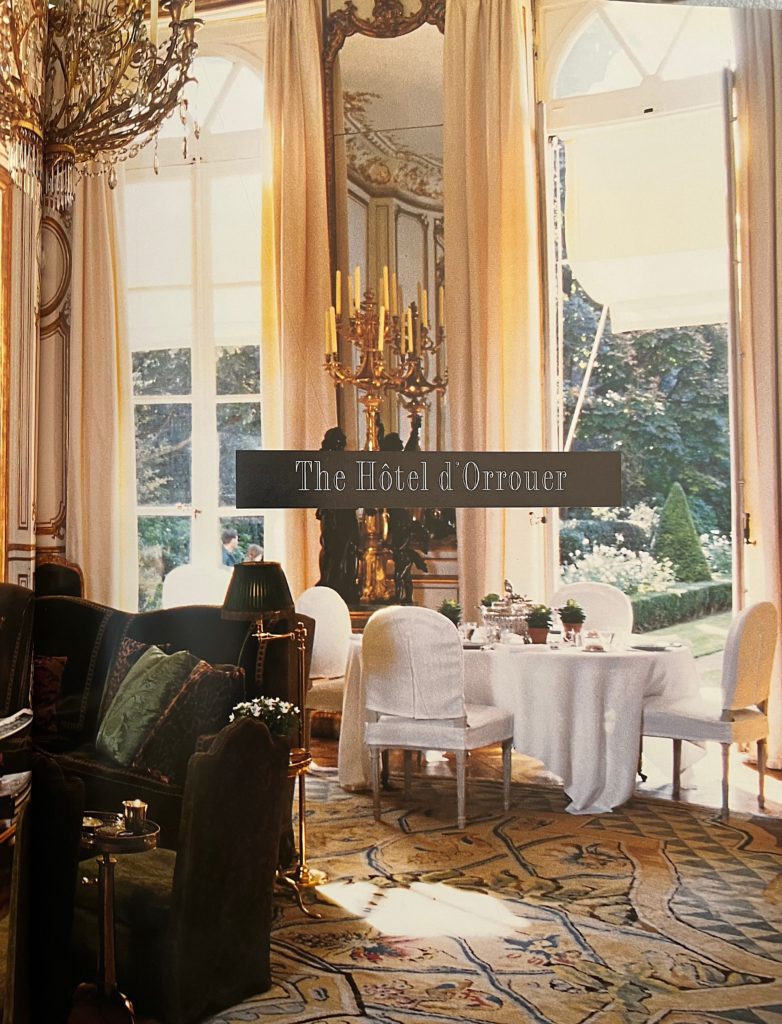
The ground floor salon as seen in The Finest Houses of Paris set with a lunch table overlooking the garden.
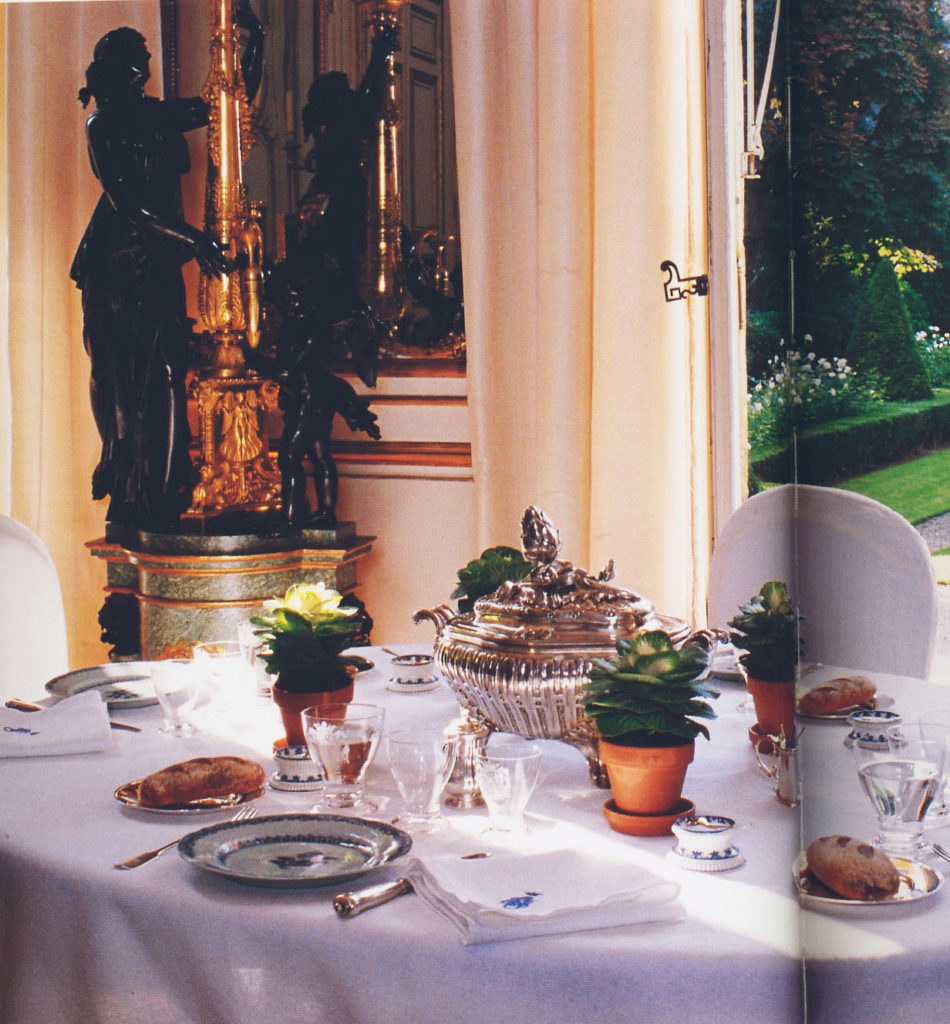
Also from The Finest Houses of Paris, “On this September morning, de Givenchy had set up a table in front of the center French doors of the living room, bathed in light: white and blue plates from Compagnie des Indes, damask napkins embroidered in blue, and engraved crystal glasses.”
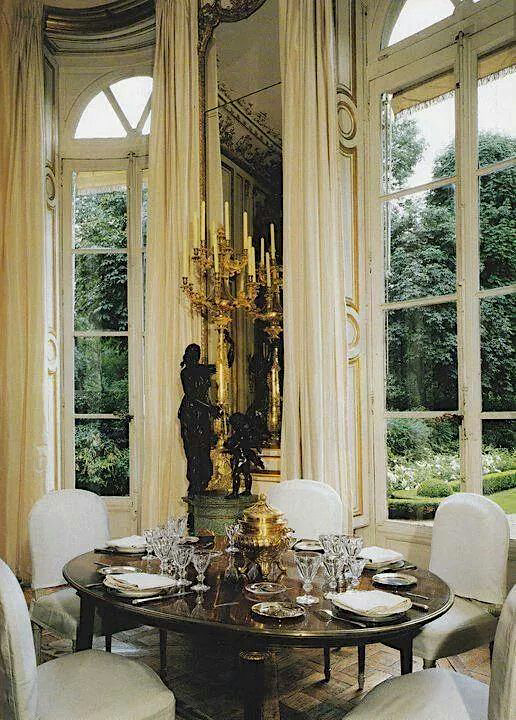
From Architectural Digest, “An 18th century table signed ‘Leleu’ is surrounded by slipcovered Louis XVI chairs. In a corner stands a Louis XVI torchère with bronze figures. The table centerpiece is a vermeil tureen. The torchères are Louis XVI.”
‘I believe that sometimes the objects you love come to you,’ he says, ‘there will be a piece that you admire in a friend’s house, then it turns up at a sale; or someone knows you love an object of theirs, and when they decide to dispose of it, they ask if you want it.’ The phenomenon has affected his collecting career more than once, he confesses. ‘I remember once dining with a friend who had a wonderful house in Neuilly,’ says discreet Hubert, ‘and after dinner, she told me she wanted to sell her Rolls Royce and asked if I wanted to see it. I told her I wasn’t interested but she insisted on waking up her chauffeur at midnight so that we could go to the garage to look at it, which we did. I told her again that I really wasn’t interested in a Rolls, but joked that if she had offered to sell me her dining table, that would be another story. Two years later, her son called to say that in her will, she’d stated that if none of her kids wanted the dining table, it should be offered to Hubert de Givenchy before anyone else.’ “
Via W magazine
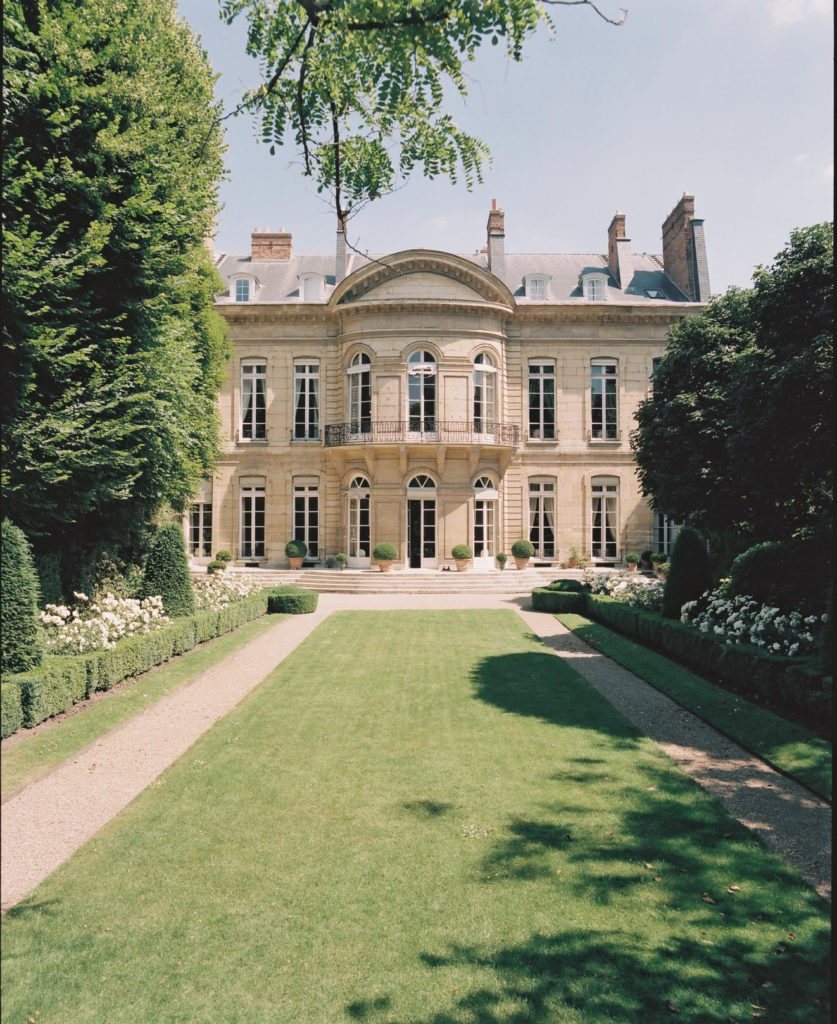
Hubert de Givenchy’s family on the upcoming sale at Christie’s: “Through this sale, we are very pleased to be able to celebrate the exceptional taste of Hubert de Givenchy and his lifelong companion Philippe Venet. We wish to share the elegance and aesthetic heritage that they have passed on to us in order to inscribe their vision in the history of art and interior design in a universal way.”
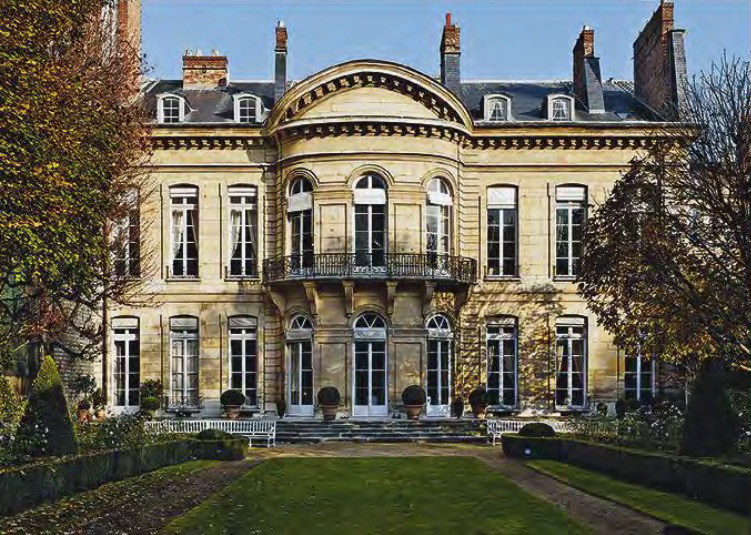
The back garden view of the house with what is described as a “tiara” pediment.
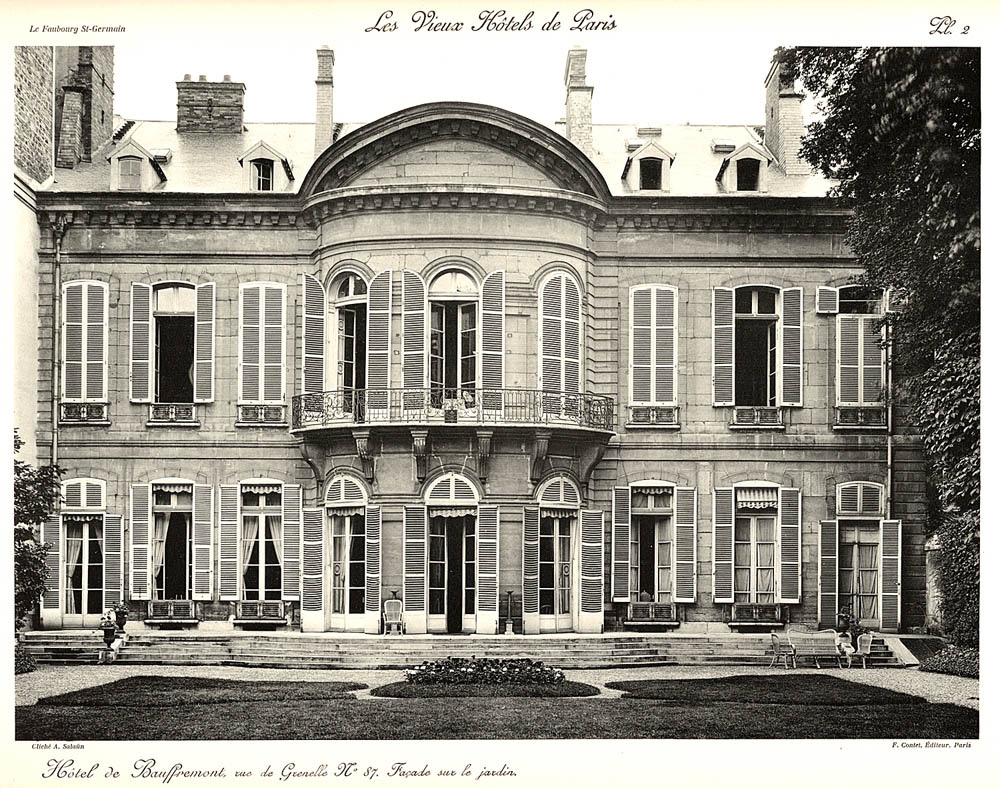
This old photo of the back of the house show that the shutters were removed here as well but it did have striped awnings on the ground floor windows and doors.
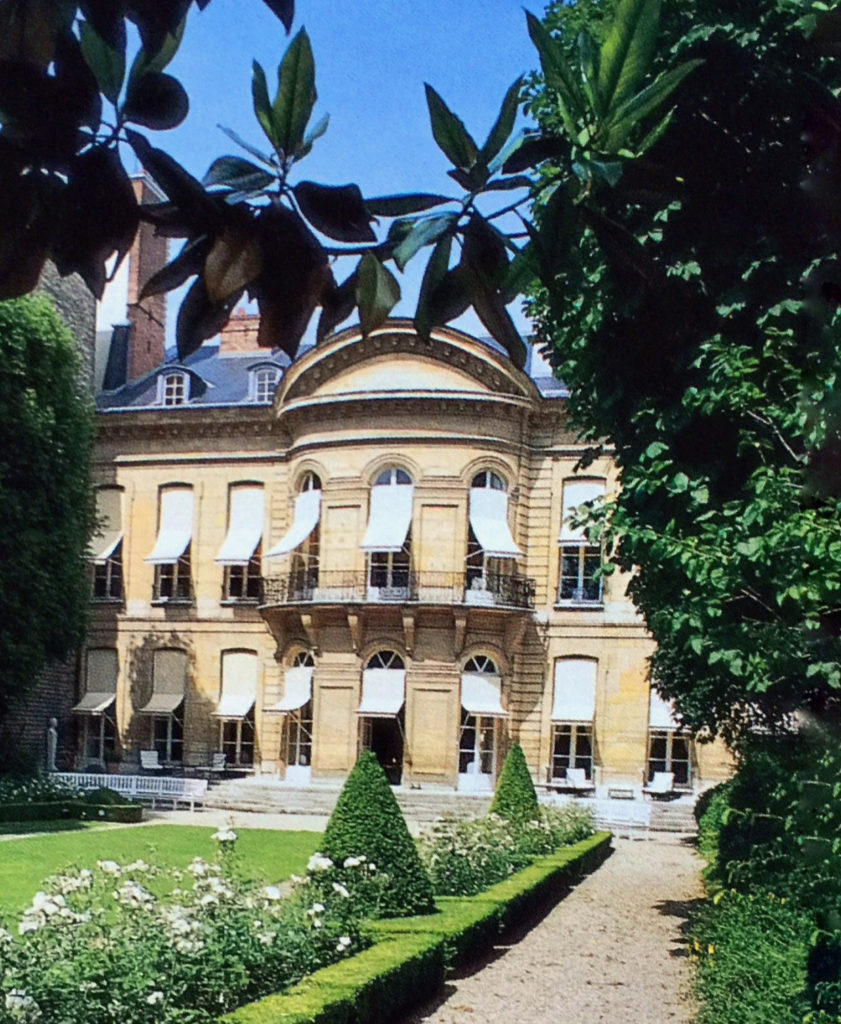
The house with the awnings down and a view of the iceberg roses and clipped hedges.

Another old photo of the garden facade.
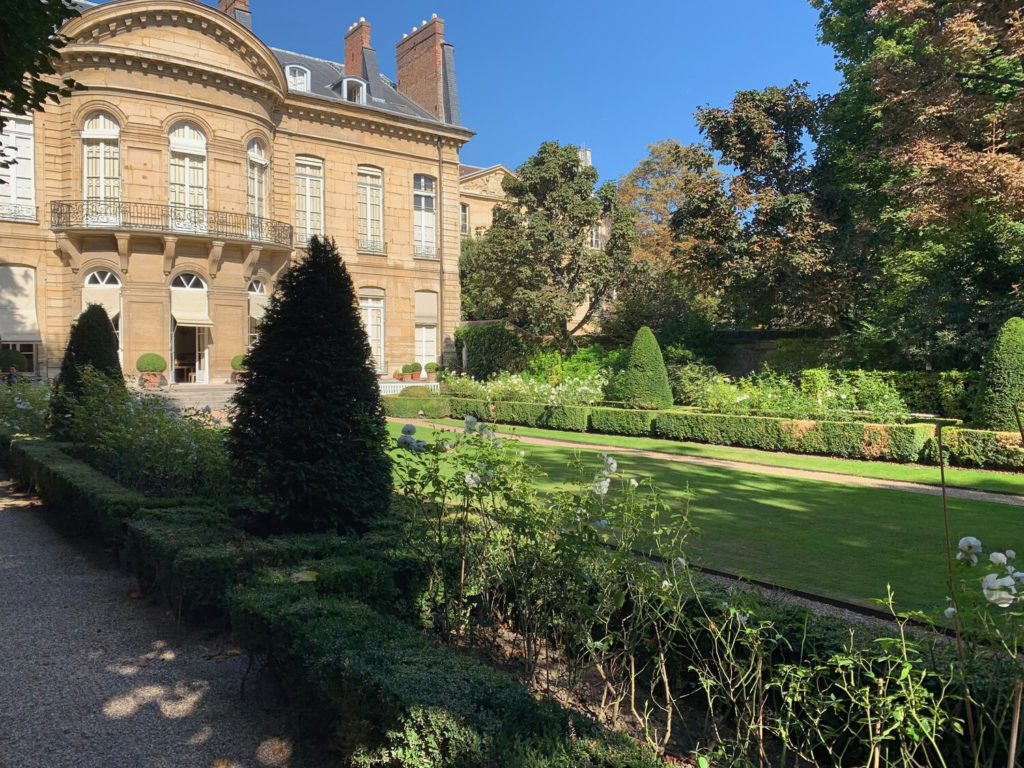
“I developed a passion for houses of a different sort – great dwelling places – as well as an enthusiasm for gardens, rare objects, and decoration.” Now, in hindsight, I can say frankly that I had two careers, one as a couturier and the other as an art lover, what the French proudly call an amateur d’art. Collecting rare objects has not only brought me great happiness; it has also, with each new discovery, increased my knowledge of beautiful things.” – Hubert de Givenchy
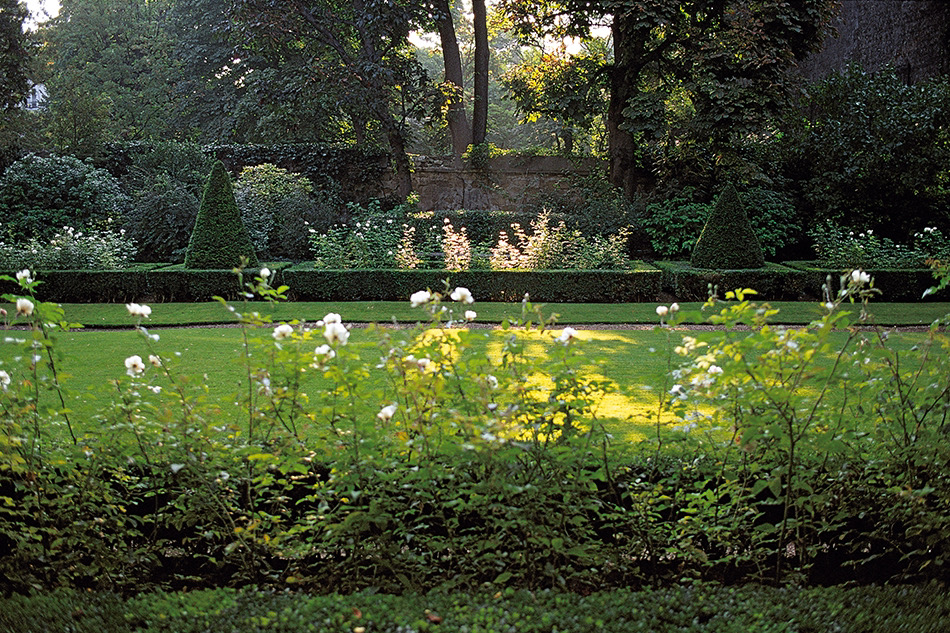
The most exciting part of the upcoming Hubert de Givenchy auction is that Christie’s will produce a touring exhibition of his collection. It will show in Palm Beach from 5 to 26 March, New York City from 8 to 13 April, and Hong Kong from 23 to 26 May. On 8 June, the exhibition viewing will open to the public in Paris ahead of the live sales 14 to 17 June and the dedicated online sales from 8 to 23 June 2022.

